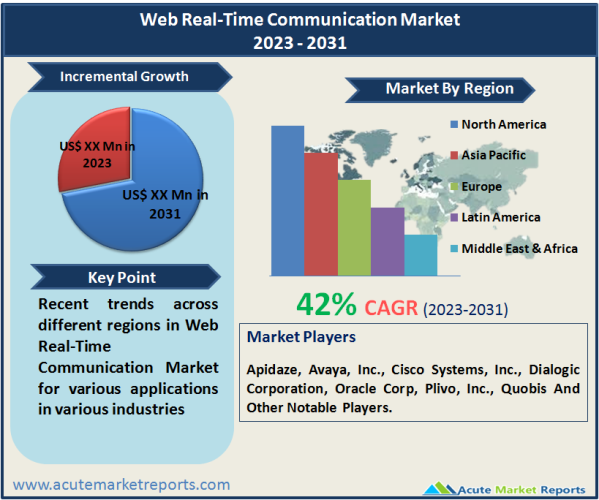
The global market for web real-time communication market is expected to grow at a CAGR of 42% during the forecast period of 2025 to 2033. Web real-time communication, or WebRTC, is an open-source initiative that provides browsers and mobile applications with real-time communication capabilities via simple APIs. As WebRTC is adaptable to various system conditions and is interoperable with Unified Communications (UC) or Voice over Internet Protocol (VoIP), it facilitates organizations' coordination and communication within their existing framework, which is anticipated to stimulate market growth. WebRTC technology's cost-effective advantages, the webification of real-time communication, and the rise in enterprise adoption of WebRTC technology are among the key factors driving the growth of the global web real-time communication market. In addition, an increase in ICT expenditures in developing nations, a rise in smartphone usage, particularly in Asia-Pacific, a rise in internet connectivity, and the development of the necessary internet infrastructure in Asia-Pacific and Africa all contribute to the expansion of the market. The lack of universal standards and rising security and privacy concerns are expected to restrain the growth of the web real-time communication market. In contrast, the integration of AI with WebRTC, the proliferation of the bring-your-own-device (BYOD) trend, and the rising use of WebRTC for the Internet of Things (IoT) provide lucrative growth opportunities for the global WebRTC market over the forecast period.

On the basis of components, the solutions segment dominated the web real-time communication market in 2021, and this trend is anticipated to continue throughout the forecast period. This is due to advantages such as eliminating the need for additional plugins or downloads, complete utilization of HTML5, JavaScript, and advanced API to embed real-time communication in the users' browsers, reduction in business costs; adoption of the cloud platform; development of universal standards by the W3 Consortium; and rise in demand for video conferencing, staff meetings, and BYOD applications, which largely drives the growth of WebRTC solutions. According to the industry vertical, the healthcare sector is anticipated to exhibit the highest growth rate for the global WebRTC market during the forecast period. This is due to the increasing popularity of telemedicine and fitness apps, as well as the integration of audio/video calling features with official hospital websites for remote patient consultation.
WebRTC Technology's Cost-Effective Advantages
WebRTC solutions are cost-effective because effective communication does not require the installation of additional plugins or software. WebRTC enables any web server to provide an exclusive real-time communication experience with high dependability, simplicity, and at reduced cost. WebRTC allows browser-based applications to emulate real-time user interactions. In addition, it provides secure web-based communication at lower costs and numerous advantages, such as simple deployment across multiple operating systems and device types, among others. These substantial benefits have allowed WebRTC technology to gain a substantial foothold among small and medium-sized businesses.
Webification Of Synchronous Communications
The "webification" of real-time communications (RTC) refers to the incorporation of communications into web pages, which makes them accessible on any screen. This is increasingly observed across numerous applications that enable voice/video real-time communication between two browsing windows without the need for additional plugins such as Flash, Java, or others. WebRTC enables web developers to create applications that combine audio, video, chat, and data collaboration without requiring voice-over-IP or telecommunications. The webification of RTC enables immediate access to communication with an individual in order to complete a task, as well as a broader context that makes communication more efficient and productive.
AI Integration with WebRTC
Artificial Intelligence (AI) is being applied in fascinating ways to WebRTC and real-time communications. For instance, callstats.io employs one such use case for WebRTC error detection and forecasting. In addition, AI with WebRTC is useful for object detection and segmentation when creating Instagram or Snapchat filters. AI can be used to ensure Quality of Service (QoS) and improve customer service for multiple WebRTC-based applications. Moreover, according to a 2018 survey by WebRTC. ventures, 39% of developers were integrating or planned to integrate a WebRTC application into an embedded device. Thus, it is anticipated that the integration of AI with web real-time communication will provide lucrative opportunities for the web real-time communication market.
The Solutions Segment Dominated the Market by Component in 2024
The solutions segment held the largest market share in 2024 with 75%, and it will grow at a steady CAGR from 2025 to 2033. The significant share can be attributed to the growing demand for advanced APIs to embed real-time communication in browsers. The solutions segment is subdivided further into video calling & conferencing, voice calling & conferencing message & file sharing, and others. Video calling & conference is anticipated to grow at the highest CAGR during the forecast period, as market participants concentrate on developing high-quality video conferencing solutions to meet the increasing demand.
The services segment is expected to record the highest CAGR in excess of 47% over the forecast period 2025 to 2033. Choosing technical assistance and services provided by WebRTC providers enables organizations utilizing WebRTC solutions to concentrate on their core business without worrying about technical issues. WebRTC service providers offer a variety of services, including technical support, training, and interconnection. The service offerings enable clients to rely on solution providers for any necessary assistance. In addition, it is anticipated that the lack of technical expertise among users will increase the demand for training and technical services.
The smartphones and Tablets Segment Dominated the Market by Enabled Device Insights
The segment of smartphones & tablets held a market share of 72% in 2024 and will maintain its dominant position throughout the forecast period. Increasing smartphone penetration is a major contributor to the large revenue share. The use of WebRTC-powered mobile applications is anticipated to sustain the segment's growth over the forecast period. Facebook Inc. and Google LLC have already released their WebRTC-based mobile applications, such as Messenger and Hangouts. In addition, the Android operating system has built-in support for WebRTC via Chrome, which is widely used on the majority of smartphones. Thus, increasing smartphone penetration is directly proportional to segment growth as a whole.
During the forecast period, it is projected that the PC market will grow at a significant CAGR. WebRTC browsers, such as Google Chrome, Mozilla Firefox, Opera, and Safari, support real-time communication on a variety of desktops, laptops, and other computing devices. In addition, the demand for video conferencing solutions is increasing across a variety of industry verticals, including IT & telecom, retail, and BFSI, with PCs being the preferred method of online business communication. Video conferencing eliminates travel time and associated expenses, allowing businesses to make quicker business decisions.
IT & Telecom Segment Dominated the End User Market
In 2024, the IT & telecom sector held the largest market share, 35%. Internet and application ecosystems have already caused disruption in the telecommunications industry. With Voice over Internet Protocol (VoIP) and social networks gaining popularity among customers worldwide, internet-based real-time communication has become crucial. Companies in the telecommunications industry are re-evaluating their traditional communication services and developing new ones to accommodate current communication trends. The healthcare segment is projected to grow at a CAGR greater than fifty percent during the forecast period. This increase is attributable to the growing adoption of telehealth platforms to enhance patient engagement and reduce additional costs. Due to the fact that patients prefer to meet their healthcare service providers conveniently regardless of location, video conferencing has become an essential component. Telehealth is being considered by healthcare organizations in order to meet patients' rising technological expectations.
North America to Remain as the Global Leader
Due to the growth of WebRTC applications in telecom & IT, BFSI, and retail sectors, the presence of a large number of WebRTC vendors, and the introduction of innovative WebRTC products, as well as the high adoption of IoT solutions, North America held the largest share of the web real-time communication market in 2024 with a revenue share of 42%. The dominance is expected to continue during the forecast period. This is due to the presence of significant market participants, such as Cisco Systems, Inc., Oracle Corporation, Ribbon Communications Operating Company, Inc., and Avaya Inc. The combination of rising demand for virtual meetings and high-speed Internet connectivity is a major factor in this region's market growth. In addition, businesses in this region are early adopters of emerging technologies, which will contribute to market expansion. During the forecast period, Asia-Pacific is anticipated to be the fastest-growing regional market. This is a result of the growing number of internet users in developing nations such as India and China. In 2017, according to the World Bank, 34.45% of India's population had internet access, up from 22% in 2016. Moreover, during the forecast period, digitalization in the region is anticipated to generate substantial market growth potential.
Product Launches Remain the Key Market Strategy
Market participants are focusing on new product launches to expand their product lines and increase their market share. For example, in March 2020, Ribbon Communications Operating Company, Inc. announced the launch of its cloud-based "Work@Home" offerings to provide enterprises with advanced remote working capabilities. The offerings include a comprehensive Unified Communications and Collaboration solution with Ribbon's smart office, which offers an HD video whiteboard, screen sharing, conferencing, and group chat on desktop and mobile devices.
To gain a competitive advantage in the market, market participants are also emphasizing inorganic strategies, such as mergers and acquisitions. For instance, Cisco Systems, Inc. announced in September 2019 the acquisition of Voicea, a provider of real-time solutions. The purpose of the acquisition was to expand Cisco System Inc.'s Webex portfolio with transcription services that combined automatic speech recognition and artificial intelligence (AI). Thus, product differentiation and strategic alliances are the primary strategies utilized by the leading market players. On the market for web-based real-time communication, notable companies include Apidaze, Avaya, Inc., Cisco Systems, Inc., Dialogic Corporation, Oracle Corp and others.
Historical & Forecast Period
This study report represents analysis of each segment from 2023 to 2033 considering 2024 as the base year. Compounded Annual Growth Rate (CAGR) for each of the respective segments estimated for the forecast period of 2025 to 2033.
The current report comprises of quantitative market estimations for each micro market for every geographical region and qualitative market analysis such as micro and macro environment analysis, market trends, competitive intelligence, segment analysis, porters five force model, top winning strategies, top investment markets, emerging trends and technological analysis, case studies, strategic conclusions and recommendations and other key market insights.
Research Methodology
The complete research study was conducted in three phases, namely: secondary research, primary research, and expert panel review. key data point that enables the estimation of Web Real-Time Communication market are as follows:
Market forecast was performed through proprietary software that analyzes various qualitative and quantitative factors. Growth rate and CAGR were estimated through intensive secondary and primary research. Data triangulation across various data points provides accuracy across various analyzed market segments in the report. Application of both top down and bottom-up approach for validation of market estimation assures logical, methodical and mathematical consistency of the quantitative data.
| ATTRIBUTE | DETAILS |
|---|---|
| Research Period | 2023-2033 |
| Base Year | 2024 |
| Forecast Period | 2025-2033 |
| Historical Year | 2023 |
| Unit | USD Million |
| Segmentation | |
Component
| |
WebRTC-enabled devices
| |
Industry Vertical
| |
|
Region Segment (2023-2033; US$ Million)
|
Key questions answered in this report